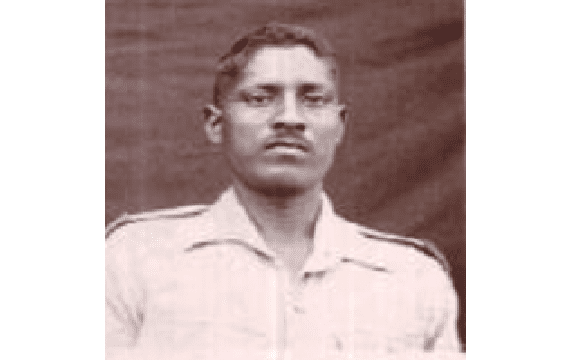
Service No : 4141367
Place of birth : Sultanpur, (UP)
Service : Army
Last Rank : Sepoy
Unit : 13 Kumaon
Arm/Regt : The Kumaon Regiment
Operation : Indo-China War 1962
Martyrdom : November 18, 1962
Sepoy Sitla Prasad
Sepoy Sitla Prasad hailed from Barnpur village in Sultanpur district, Uttar Pradesh—a region steeped in a proud military heritage and a longstanding commitment to national service. Inspired by a deep sense of patriotism, he joined the 13 Kumaon Battalion of the esteemed Kumaon Regiment, one of the Indian Army’s oldest and most distinguished infantry units. With origins tracing back to the 18th century, the regiment has earned a formidable reputation for its courage, professionalism, and gallantry in numerous military campaigns.
As a soldier, Sepoy Sitla Prasad was admired for his unwavering dedication, discipline, and commitment to duty. He wore the Kumaoni uniform with immense pride and faithfully upheld the values and traditions of his battalion. By 1962, his unit was stationed in Ambala and was subsequently deployed to Jammu & Kashmir—an affirmation of the trust placed in their readiness and strategic importance.
Battle of Rezang La (Indo-China War): 18 Nov 1962
In June 1962, Sepoy Sitla Prasad’s unit—the 13 Kumaon Battalion—under the command of Lt Col H.S. Dhingra, was redeployed from Ambala to Baramulla in Jammu & Kashmir. As tensions with China escalated later that year, the battalion received sudden orders in September to move to Leh. Upon arrival, it was placed under the operational control of the 114th Infantry Brigade, commanded by Brigadier T.N. Raina, who would later serve as the Chief of Army Staff. Tasked with defending a vast 400-kilometre stretch of the Indo-China border, including the strategically vital Chushul sector, the brigade also included four other battalions: 14 J&K Militia, 7 J&K Militia, 5 Jat, and 1/8 Gorkha Rifles. Sepoy Sitla Prasad was part of ‘C’ (Charlie) Company of 13 Kumaon, led by the legendary Major Shaitan Singh. According to the brigade's defensive deployment plan, Charlie Company was assigned to hold Rezang La, a crucial mountain pass approximately 11 km south of Spanggur Gap, which overlooked the road connecting Leh via Dungti—the lifeline to the Chushul garrison.
‘A’ Company, commanded by Major G.N. Sinha, was held in reserve at battalion headquarters near Chushul, while ‘B’ and ‘D’ Companies were stationed on Maggar Hill under the command of Captain R.V. Jatar. By 26 October 1962, Sepoy Sitla Prasad and his fellow soldiers had fortified their positions in anticipation of enemy action. The deployment of Charlie Company was strategically planned to exploit terrain advantages and ensure maximum defense capability. Platoon 7, under Jemadar Surja Ram, secured the northern flank; Platoon 8, led by Jemadar Hari Ram, held the pass; and the central post was manned by Platoon 9, under Jemadar Ram Chander, supported by the Company HQ. A mortar section, commanded by Naik Ram Kumar Yadav, was placed on the reverse slope.
On 18 November 1962, the Chinese launched a coordinated offensive, mirroring their simultaneous assault on Sela in the Northeast Frontier Agency (NEFA). A two-pronged attack was directed at the Chushul defenses—one towards Gurung Hill, and the other at Charlie Company’s position at Rezang La. The first enemy wave emerged around 2:00 AM, targeting Platoon 8 with a column of approximately 30 soldiers. The movement was detected by the Listening Post, and Naik Hukam Chand immediately alerted Jemadar Hari Ram. Following swift coordination with Major Shaitan Singh, orders were given to engage the enemy. When the Chinese force came within 50 yards, Naik Hukam Chand gave the command to open fire, successfully repelling the initial attack.
At 4:00 AM, a second wave approached from the direction of Platoon 7. Jemadar Surja Ram quickly repositioned Section Three to a more advantageous location and launched a counterattack using rifles, grenades, and light machine guns. This assault, too, was thwarted thanks to the resolute leadership of Jemadar Surja Ram and the bravery of Naik Sahi Ram’s section. The Chinese launched successive attacks at 4:55 AM, 6:00 AM, and 6:30 AM, each more intense than the last. Despite mounting casualties and equipment losses, Sepoy Sitla Prasad and his comrades held their ground. By 7:40 AM, during the sixth wave, the defenders were heavily depleted. At 8:40 AM, the Chinese introduced a 57 mm recoilless rifle, clearly positioned on a ridge, signaling the beginning of the final assault. At 9:00 AM, the seventh and deadliest wave of enemy troops charged. Despite freezing temperatures, punishing terrain, and relentless bombardment, Sepoy Sitla Prasad and the soldiers of Charlie Company fought with unmatched determination. Severely wounded during the battle, Sepoy Sitla Prasad made the supreme sacrifice.
He and his fellow soldiers fought to the last man and the last bullet, their defiant stand halting the Chinese advance and safeguarding the strategically vital Chushul airfield. Following the ceasefire, Rezang La fell into a contested no-man’s land. The bodies of Sepoy Sitla Prasad and his fallen comrades lay frozen in the snow until discovered nearly three months later by a local shepherd.
Sepoy Sitla Prasad is survived by his mother, Smt Pandri.

No Comments